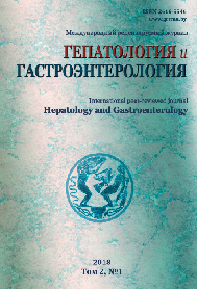ОЦЕНКА ДОПОЛНИТЕЛЬНЫХ МЕТОДОВ ДИАГНОСТИКИ СПОНТАННОГО БАКТЕРИАЛЬНОГО ПЕРИТОНИТА У ПАЦИЕНТОВ С ЦИРРОЗОМ ПЕЧЕНИ
Аннотация
Введение. Для диагностики спонтанного бактериального перитонита (СБП) ведется поиск дополнительных методов исследования.
Цель исследования – уточнение диагностической значимости методов подсчета полиморфноядерных лейкоцитов (ПЯЛ) в автоматическом гематологическом анализаторе (АГА) и определения ПЯЛ с помощью индикаторных тест-полосок для анализа мочи для диагностики СБП.
Материалы и методы. Исследование асцитической жидкости (АЖ) проведено 57 пациентам с циррозом печени и асцитом. Подсчет ПЯЛ проводился при микроскопии АЖ ручным методом, в АГА (NIHON KOHDEN 6410К, Япония), определялись ПЯЛ с помощью индикаторых тест-полосок для исследования мочи (URIstik A10, Китай и Мульти Тест10, Республика Беларусь).
Результаты. Метод подсчета ПЯЛ для диагностики СБП с помощью АГА NIHON KOHDEN 6410К демонстрирует низкую чувствительность (50,0%). Установлена сильная статистически значимая корреляция (r=0,880, 95% ДИ 0,804-0,928, р<0,001) между общим число лейкоцитов (ОЧЛ), подсчитанных АГА, и числом ПЯЛ (в 1 мкл), подсчитанных при микроскопии ручным методом. Для диагностики СБП определение ОЧЛ в АЖ в АГА оптимальным соотношением чувствительность (Ч)/специфичность (С) обладала точка отсечения 400 клеток в 1 мкл, наиболее точным пороговым уровнем – 900 клеток в 1 мкл. При исследовании ПЯЛ в АЖ с помощью тест-полосок оптимальным пороговым значением по соотношению Ч/С для тест-полосок URIstik A10 было 2, для Мульти Тест10 – 1; максимальной диагностической точностью обладали значения >3 для обоих наборов.
Заключение. Диагностика СБП может осуществляться наряду с подсчетом ПЯЛ при микроскопии методами подсчета ОЧЛ в АГА и с помощью тест-полосок.
Литература
1. Jalan R, Fernandez J, Wiest R, Schnabl B, Moreau R, Angeli P, Stadlbauer V, Gustot T, Bernardi M, Canton R, Albillos A, Lammert F, Wilmer A, Mookerjee R, Vila J, Garcia-Martinez R, Wendon J, Such J, Cordoba J, Sanyal A, Garcia-Tsao G, Arroyo V, Burroughs A, Gines P. Bacterial infections in cirrhosis. A position statement based on the EASL Special Conference 2013. J. Hepatol. 2014;60(6):1310-1324. doi: 10.1016/j.jhep.2014.01.024.
2. Fernandez J, Gustot T. Management of bacterial infections in cirrhosis. J. Hepatol. 2012;56(Suppl 1):S1-12. doi: 10.1016/S0168-8278(12)60002-6.
3. European Association for the Study of the Liver. EASL clinical practice guidelines on the management of ascites, spontaneous bacterial peritonitis, and hepatorenal syndrome in cirrhosis. J. Hepatol. 2010;53(3):397-417. doi: 10.1016/j.jhep.2010.05.004.
4. Runyon BA. AASLD Practice Guideline. Introduction to the Revised American Association for the Study of Liver Diseases Practice Guideline. Management of Adult Patients With Ascites Due to Cirrhosis 2012. Hepatology. 2013;57(4):1651-1653. doi: 10.1002/hep.26359.
5. Fernandez J, Acevedo J, Prado V, Mercado M, Castro M, Pavesi M, Arteaga M, Sastre L, Juanola A, Gines P, Arroyo V. Clinical course and short-term mortality of cirrhotic patients with infections other than spontaneous bacterial peritonitis. Liver Int. 2017;37(3):385-395. doi: 10.1111/liv.13239.
6. Fasolato S, Angeli P, Dallagnese L, Maresio G, Zola E, Mazza E, Salinas F, Dona S, Fagiuoli S, Sticca A, Zanus G, Cillo U, Frasson I, Destro C, Gatta A. Renal failure and bacterial infections in patients with cirrhosis: epidemiology and clinical features. Hepatology. 2007;45(1):223-229. doi: 10.1002/hep.21443.
7. Gu C, Song MY, Sun WJ, Xu XY, Yang CQ, Chen DF. Advances in basic and clinical research on liver cirrhosis in 2016. Zhonghua Gan Zang Bing Za Zhi. 2017;25(1):5-8. doi: 10.3760/cma.j.issn.1007-3418.2017.01.003.
8. Shaikh, MM, Morgan M. Sepsis caused by Raoultella terrigena. JRSM Short Rep. 2011;2:49-51. doi: 10.1258/shorts.2011.010127.
9. Carrillo ER, Tellez MA, Salinas RS. Staphylococcus xylosus: una bacteria emergente. Rev. Med. Hosp. Gen. Mex. 2000;63(2):107-111.
10. Riggio O, Angeloni S, Parente A, Leboffe C, Pinto G, Aronne T, Merli M. Accuracy of the automated cell counters for management of spontaneous bacterial peritonitis. World J. Gastroenterol. 2008;14(37):5689-5694. doi: 10.3748/wjg.14.5689.
11. Angeloni S, Nicolini G, Merli M, Nicolao F, Pinto G, Aronne T, Attili AF, Riggio O. Validation of automated blood cell counter for the determination of polymorphonuclear cell count in the ascetic fluid of cirrhotic patients with or without spontaneous bacterial peritonitis. Am. J. Gastroenterol. 2003;98(8):1844-1848.
12. Nousbaum JB, Cadranel JF, Nahon P, Khac EN, Moreau R, Thevenot T, Silvain C, Bureau C, Nouel O, Pilette C, Paupard T, Vanbiervliet G, Oberti F, Davion T, Jouannaud V, Roche B, Bernard PH, Beaulieu S, Danne O, Thabut D, Chagneau-Derrode C, de Ledinghen V, Mathurin P, Pauwels A, Bronowicki JP, Habersetzer F, Abergel A, Audigier JC, Sapey T, Grange JD, Tran A. Diagnostic accuracy of the Multistix 8 SG reagent strip in diagnosis of spontaneous bacterial peritonitis. Hepatology. 2007;45(5):1275-1281. doi:10.1002/hep.21588.
13. Garcia-Tsao, G. Current management of the complications of cirrhosis and portal hypertension: variceal hemorrhage, ascites, and spontaneous bacterial peritonitis. Dig. Dis. 2016;34(4):382-386. doi: 10.1159/000444551.
14. Rimola A, Garcia-Tsao G, Navasa M, Piddock LJ, Planas R, Bernard B, Inadomi JM. Diagnosis, treatment and prophylaxis of spontaneous bacterial peritonitis: a consensus document. J. Hepatol. 2000;32(1):142-153.
15. Moore KP, Aithal GP. Guidelines on the management of ascites in cirrhosis. Gut. 2006;55(Suppl 6):1-12. doi: 10.1136/gut.2006.099580.
16. Lutz P, Pfarr K, Nischalke HD, Krämer B, Goeser F, Glässner A, Wolter F, Kokordelis P, Nattermann J, Sauerbruch T, Hoerauf A, Strassburg CP, Spengler U. The ratio of calprotectin to total protein as a diagnostic and prognostic marker for spontaneousbacterial peritonitis in patients with liver cirrhosis and ascites. Clin. Chem. Lab. Med. 2015;53(12):2031-2039. doi: 10.1515/cclm-2015-0284.
17. Lee SS, Min HJ, Choi JY, Cho HC, Kim JJ, Lee JM, Kim HJ, Ha CY, Kim HJ, Kim TH, Kim JH, Lee OJ. Usefulness of ascitic fluid lactoferrin levels in patients with liver cirrhosis. BMC Gastroenterol. 2016;16(1):132. doi:10.1186/s12876-016-0546-9.


















2.png)






